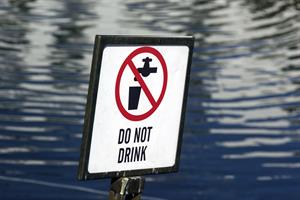 Tens of thousands of small streams run through backyards and community parks across America. Children wade through them. Dogs jump excitedly into them, stopping occasionally to drink. Anglers cast their lines to catch a bite for dinner. We explore, play, and fish in our local streams and trust that someone will tell us if the water is unsafe.
Tens of thousands of small streams run through backyards and community parks across America. Children wade through them. Dogs jump excitedly into them, stopping occasionally to drink. Anglers cast their lines to catch a bite for dinner. We explore, play, and fish in our local streams and trust that someone will tell us if the water is unsafe.
In reality, there is an alarming lack of information about water quality in this country. The water crisis in Flint, Michigan, is a prime example. High levels of lead in the water are the result of highly acidic water running through city pipes. Scientists say that chemical testing of the Flint River could have predicted the corrosive effect the water would have after decades of industrial pollution and agriculture runoff.
However, the vast majority of U.S. waterways are never checked for water quality. In fact, only 28 percent of waterways nationwide are ever tested, even though the Clean Water Act requires states to monitor and report on the quality of all waterways. Many of these waters are tested only once every five to ten years, and one or two sites may be used to gauge the quality of many miles of streams.
The limited information we do have about water health paints a grim picture: 55 percent of monitored waterways are not suitable for swimming or fishing, let alone as sources of drinking water.
Most states just don’t devote enough resources to monitoring waterways. To compound the problem, EPA and states are not transparent in how they present the information they do have to the public. The average citizen visiting an EPA or state Web site would likely come away with the impression that most streams in their state are monitored regularly for pollution. They would have no idea that states assess the health and safety of our waters with outdated data or that one monitoring spot may be used to represent the health of many miles of streams — in some cases, miles downstream from that spot.
This is a far cry from the original intent of the Clean Water Act to assess all of our nation’s waterways, identify impaired waters, and restore those impaired waters. It also leaves a lot of questions unanswered about the safety of the majority of our backyard streams.
While this problem is serious, people like you and me can help solve it. The Izaak Walton League has trained and supported volunteer water quality monitors for more than 25 years through our Save Our Streams (SOS) program. Unfortunately, most states are not using volunteer data in spite of the fact that studies have shown that volunteers — when properly trained and supported — can collect data as accurately as professionals working for state agencies.
The utility and reliability of volunteer data is gaining greater recognition. In fact, in October 2015, the White House launched a new citizen science initiative to encourage greater use of volunteer-collected data by federal and state agencies. In some cases, though, volunteer networks are not well established and in other cases, more volunteers are needed. The Izaak Walton League can help address both needs.
This year, the League will be working to raise public awareness about these issues, recruit and train volunteer water quality monitors, and ultimately increase the percentage of waterways monitored. You can help. Let us know if you’re interested in starting a water quality monitoring group or want to join an existing group. Ask your state department of environmental quality whether it accepts citizen data on water quality. And talk with your neighbors about the need to expand water quality monitoring efforts. We have the tools to help you get started. E-mail sos@iwla.org for more information.
After all, we have a right to know what’s in our water.
Clean Water: Your Right To Know
On April 12, 2016, Izaak Walton League produced an executive report on stream monitoring in the country, state by state. How does your state rate? Find out in our "Clean Water: Your Right To Know" report.